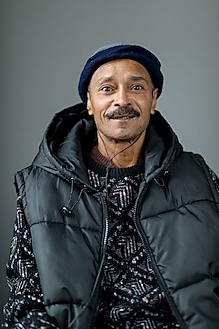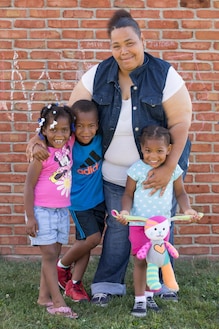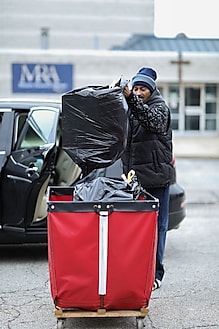Finding Shelter isn't so Simple
When Erica found a low-rent home that would fit her large family, she thought it was too good to be true — and it was.
Erica was working hard as a daycare provider and paying her bills, but her landlord soon started giving her strange instructions on how to use the home’s utilities. First, the family was told to take showers and wash clothes late at night and on the weekends.
Soon, the landlord was asking Erica to pay for all sorts of repairs, but even though Erica gave her the money, the repairs were never made. The furnace was broken, so Erica and her children huddled around space heaters in the cold. The last straw came when county inspectors arrived to test the water for lead.
Instead of caring for her young tenants’ health, the landlord avoided responsibility completely and claimed that Erica and her children were squatters.
In the dead of winter, Erica and six freezing little children found themselves homeless.
Unforgiving Cleveland Winters
We all remember the brutal days when the temperatures plummeted well below 32 degrees. With the sharp wind and biting air, walking from the car to the office felt intolerable. Sadly, the truth is that many men, women, and children like Erica and her family spent not only a few moments in the harsh elements, but days.
While some sleep in doorways and on the streets, others attempt refuge in less obvious spaces. Whether huddled in cars, camping in an abandoned building or covered up with leaves in a park, Clevelanders experiencing homelessness will try anything to survive.
Bruce, a recent graduate of The City Mission’s Crossroads Men’s Crisis Center program, knows exactly what this struggle feels like. Bruce, however, chose a third option. 
Well into his 60s, Bruce suffered from addiction for decades and had reached the end of his rope.
“I lived down by a creek. I dug a ditch and I laid on the ground,” Bruce said. “I put leaves and dirty blankets down. I laid there for a long time.” A long time turned into a year. Bruce stayed in his makeshift bed through every season, including a devastating Cleveland winter where he had nothing but one pair of coveralls to keep him warm. “I wanted to die so bad,” Bruce remembers.
Health Risks for the Homeless
Concerns arise for the homeless during the most extreme winter weather, but hypothermia can actually set in at temperatures just below 50 degrees. As temperatures drop the risk for exposure-related illness, conditions such as frostbite, and even death increase dramatically. This is especially true for individuals experiencing homelessness who might be very young or old, malnourished, exhausted, or have preexisting health conditions.
As a senior citizen going through withdrawals and standing at over six feet tall, it’s a wonder Bruce stayed hidden and survived last winter in his unsheltered encampment. According to a study done by the National Coalition for the Homeless earlier this decade, he could have easily been one of the 700 homeless individuals who die annually from hypothermia.
Why So Many are Unsheltered
The question many ask about people like Erica and Bruce is, “Why didn’t they go to a shelter?” While the answer is different for every individual, a few clear themes emerge:
- Lack of Available Beds
- Unfortunately, the need for shelter is greater than what is available even on mild-temperature days. This is especially true for facilities that accept families. Over the last 10 years, Cuyahoga County lost 540 beds for families and individuals in shelters and transitional housing. For women with children like Erica, their options for sufficient and safe care are limited and often have a waiting list.
- Fear of Staying in a Shelter
- Some shelters can carry a reputation for being unsafe or unsanitary. When shelters are understaffed and overcapacity, there is a higher potential for violence and theft. Other concerns such as contracting lice, bed bugs or the flu can keep people out of shelters too.
- Mental Health
- Some individuals may hold a deep skepticism of shelters due to unaddressed mental health concerns or past trauma that they experienced while previously staying in a shelter. In their minds, staying on the streets seems like a better alternative to trusting an organization with open doors.
Heartbreakingly, for these and many other reasons, families and individuals either choose to — or are forced to — take the chance surviving on their own, putting them at high risk for death and the other health concerns shared above.
What’s Being Done?
 Erica and Bruce have something in common — they found refuge, and eventually stability, at The City Mission. At any given time, The City Mission is able to host approximately 285 men, women, and children in their long-term programs year-round. As temperatures become life-threatening, the mission opens its doors wider. When The City Mission is in Emergency Overflow Mode, no one is turned away at Crossroads, or the Mission’s other program, Laura’s Home Women’s Crisis Center.
Erica and Bruce have something in common — they found refuge, and eventually stability, at The City Mission. At any given time, The City Mission is able to host approximately 285 men, women, and children in their long-term programs year-round. As temperatures become life-threatening, the mission opens its doors wider. When The City Mission is in Emergency Overflow Mode, no one is turned away at Crossroads, or the Mission’s other program, Laura’s Home Women’s Crisis Center.
“I was going to go get a hotel room and pray that something would open up, but when I called Laura’s Home, they said I could come here,” Erica recalls.
That day her family’s life was changed. Erica’s one night stay eventually became her choice to join the Laura’s Home program. Over the course of a year she and her children were empowered by wraparound services such as professional onsite childcare, life skills classes, and career and housing guidance.
As for Bruce, he is in recovery from his addiction, up to 158 pounds, and now has a place of his own. Bruce comes back every week to volunteer at The City Mission’s donation warehouse and mentor men at Crossroad.
“Maybe I can save somebody’s life so they don’t end up like me. If I can help somebody, talk to somebody, to help enable one person, it’s worth it,” he says boldly. 
The City Mission and other organizations that assist people experiencing homelessness during dangerous weather depend on the community to support them when resources are already taxed.
If you would like to make more stories of transformation like Erica and Bruce’s possible, contact a place close to your heart and ask how you can help. The City Mission has a handy Amazon Wish List of basic needs that can be shipped directly to their campuses, as well as a specific cold weather donation page where you can fund nights of shelter for a family or individual. You can also make yourself aware of organizations that aid people in extreme cold, and be ready to share that information with anyone in need of assistance that you may come across.
Stay warm and do good, Cleveland.

